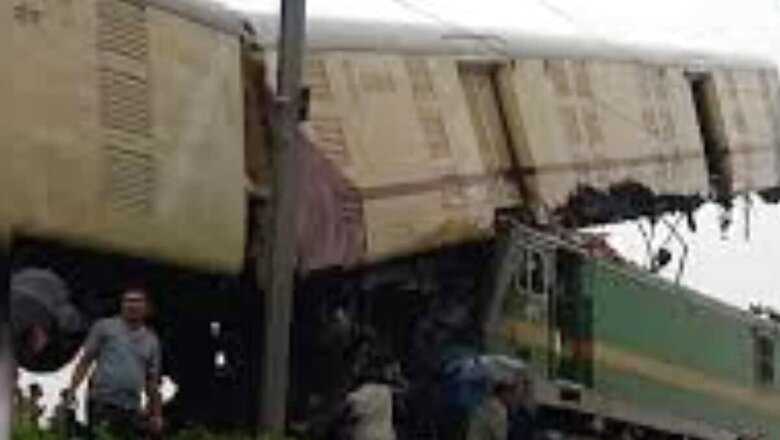
views
On June 17 morning, a railway accident killed scores of people near the Rangapani station (about 30 km from north Bengal’s New Jalpaiguri station) in the Katihar division of Northeastern Frontier Railway (NFR). Four compartments of the Sealdah-bound Kanchanjungha Express derailed (two went turtle) after being hit by a goods train from the rear.
There’s still no confirmed number of the dead, with the casualty varying from 6 to 15; the number of the injured varies between 30 and 60. The casualty could have been much higher but for the fact that the locomotive of the freight train rammed from behind the stationary express train, with the guard’s brake-van and two parcel vans facing the direct brunt of the accident. Had it been a collision between two express trains, the number of casualties would have been much higher — similar to what was witnessed during the Coromandel Express accident last year, in which at least 296 people died and more than 1,200 injured.
Decoding the reasons behind an accident is the domain of the Commissioner Railway Safety (CRS). But the Railway Board jumped the gun, saying: “The goods train driver violated the signal.” Contrarily, other reports quoting railway sources suggest there was automatic signal failure that morning and the goods train driver was issued a written authority by the Ranipatra station master, authorising him to pass all automatic signals between RNI (Ranipatra Station) and CAT (Chattar Hat Junction). If the truth is contrary to what the railway board opined initially, it is time for unconditional public apology.
Railway Minister at Site
Like the Balasore accident, where the railway minister supervised the relief and rescue operation day and night, he landed at the site of the latest accident too. It raises a fundamental question: With NDRF, SDRF, state police, district administration, local citizens, and railway personnel at the accident site, why should the railway minister be present there? And whether his presence galvanises or impedes the rescue and restoration operations.
Behind every such avoidable mayhem, there are at least dozens, if not hundreds, of cases of near miss of this type, and it is the composite failure of the railway authorities to not take these near-misses seriously despite other wise laudable achievement of Indian Railways running nearly 24000 passenger trains daily and carrying 1.59 billion tonnes of goods annually.
Blame Game Begins
True to their skin, politicians of all hues have spoken. While all are sympathetic to the dead and the injured, the Opposition is unanimous in training its guns on the government, especially railway minister Ashwini Vaishnaw. The Congress has blamed the minister for “mismanagement”, and being “busy with making reels”, thus having no time to discuss safety of the people.
Former railway minister and current Bengal Chief Minister Mamata Banerjee, in whose state the latest accident has taken place, has the following to say: “This government is only interested in elections. How to go for hacking… how to go for manipulation… They do not take care of amenities… bathrooms are dirty and there are dirty things in bedding… They do not take care of the railway staff.”
The railway minister responded, saying that “this is not the time for politics and the “rescue operation has” to be “completed” first.
Ironically, during Mamata Banerjee’s stint as railway minister, an accident involving the Howrah-Lokmanya Tilak Terminus Jnaneswari Super Deluxe Express saw at least 140 people killed and more than 200 injured.
Blood Stained
I do not have the complete record of railway accidents since 1853 when the first train ran between Boribunder and Thane in the country. But Wikipedia has records of railway accidents since 1901, and the twentieth century began with a major accident when on September 12, 1902, a derailment of the Bombay-Madras Mail on a bridge near Mangapatnam, Kadapa district killed 100 passengers.
A careful perusal of all the railway accidents since formation of the interim government by Jawaharlal Nehru in 1946 brings out the humbling truth of every railway minister encountering major accidents during his respective tenures. Governments have come and gone but the accidents have stayed put obdurately. With the political memory fragile, it would be important to remember that the worst accident in the history of Indian railways took place at Badlaghat in Bihar in 1981 during Congress regime in which an estimated 300-800 people perished when the entire train plunged in the Bagmati river. Till date the cause of the accident is shrouded in mystery.
The Kanchanjungha Express accident is the first major accident of the year. Notwithstanding the fact that the year 2023 saw a major spike in the railway accident, nonetheless, the last 10 years of Prime Minister Narendra Modi or for that matter the tenure of railway minister Ashwini Vaishnaw has been a shade better than their predecessors.
Elephant in the Room
Near misses, incidents and accidents in Indian Railways follow the typical parable of an elephant and six blind men of India. The entire story of identification of near-misses, incidents, and accidents in IR, is full of deceit and dishonesty where every department, every division and every zone are busy in massive operation cover up and not letting the truth out. Branch officers keep Division Railway Manager in the dark, who in turn does the same with the General Manager and the distant railway board mandarins sitting on the second floor of the “Rail Bhawan” are perennially in the dark and blissful in their ignorance. It is saddening to note that in the present era of instant connectivity, IR is unable to record-near-misses, incidents, and accidents real time.
Causes Galore
There are causes galore of why accidents continue to happen in India and why IR does not learn the lesson. Here are few of them:
One, railway safety is baby of none: And the principal reason is that even after the passage of twelve years since the submission of the report of the “High Powered Committee on the Railways Safety” headed by noted scientist Dr. Anil Kakodkar, IR is yet to implement its recommendation of setting up an independent safety architecture in form of the Rail Safety Authority (RSA). The Railway Ministry continues to play the role of police, pleader, and judge, with the rule-making, operations and the regulation all vested in the Railway Board. There is no oversight body to safeguard railway safety.
Two, whither Raksha Kavach: The trend of IR accidents in the last three decades is unmistakable: The bulk of accidents are caused by human error. Also, with substantial reduction in manned and unmanned level crossings, collisions have become bigger killers. A NITI Aayog report found that human failure, including the fault of railway staff, caused 87 per cent of the 586 consequential accidents recorded between 2012-13 and 2016-17. Worse, year-on-year, the share of fault of railway staff in accidents grew incrementally. Raksha Kavach, originally invented and patented by Konkan Railway, is one definitive way to stop collisions.
Had there been Kavach, the Kanchanjungha Express accident would have possibly been stopped. But thus far Kavach has been installed only on 1,500 km of the track and railways plans to extend it to 3,000 km in near future.
Three, IRMS is a flawed reform: It will come as a surprise to readers that the biggest chunk of IR officers are doctors. Historically, Indian Railways used to attract the country’s best talent from the Indian Civil Services Exam and Indian Engineering Services Exams as Class I officers. The Indian Railways Management Service (IRMS) has been a blotched reform. It is proving to be a nostrum that will kill the patient without curing the illness. I get nightmares thinking who will manage old, decrepit IR bridges in future and what will happen if one of the distressed IR bridges has its Morbi bridge moment. Even the committee headed by Bibek Debroy had recommended combining eight railways’ services into two — one general service and another technical service.
Four, poor human resource, poorer training: While the recruitment of Class-I officers in IR has been marred in controversy after introduction of IRMS, less said the better about the recruitment and quality of Class-III and Class-IV staff.
Here is one example: On January 30, 2024, Principal Special Judge for Central Bureau of Investigation, Hyderabad, Madhusudhan Rao in a case that saw justice after 14 years, sentenced the then Chairman of Railway Recruitment Board, Mumbai, Satendra Mohan Sharma, the then Chief Executive Officer of Hassan-Mangalore Rail Development Corporation A.K. Jagannadham and eight others to five years’ rigorous imprisonment along with a fine of Rs 7,87,000 in a case pertaining to paper leak of an exam conducted by RRB for posts of ‘assistant station master’ and ‘assistant loco pilot’ in 2010.
This is just the tip of the iceberg and the real malaise lies much deeper. Also, there are many back-channels for children of railway men to get jobs in IR: one is known as medical decategorisation. The appointment of Class-IV staff is among the most non-transparent recruitments in the country.
What is more surprising is the growing apathy of IR towards training and also lack of training opportunities. The National Academy of Indian Railways (NAIR), Vadodara, one of the finest training institutions to train Class-I officers in the country, has been dismantled. Zonal Railways still have something known as Zonal Training School (ZTC), but their curriculum, faculty, teaching methods and teaching standards have become pathetic. And, in the last four decades, at least this author has not seen a proper training centre in a railway division office (an average railway division has 18,000-30,000 employees).
Rewind and Reboot
For IR, it is the time to introspect, retrospect and make a firm resolve to let go of the “chalta hai” attitude, and imbibe the “Mission Zero Rai Fatality” statutorily. This statement of the author reminds him of Bill 1996/97:137 introduced and passed in Swedish Parliament to chart out the mission zero death goal for road fatalities in that country and it indeed achieved that goal. What Sweden can do vis-à-vis road fatalities; it is time for IR to do the same for rail fatalities. It is imminently doable.
If there is any doubt, IR needs to look at the Japanese Railway East (JR East) whose Shinkansen trains are incident free for decades, and which has a Rail Accident Museum to train its personnel.
The author is Multidisciplinary Thought Leader with Action Bias, India Based International Impact Consultant, and key watcher of changing national scenario. He works as President Advisory Services of Consulting Company BARSYL. Views expressed in the above piece are personal and solely those of the author. They do not necessarily reflect News18’s views.
















Comments
0 comment